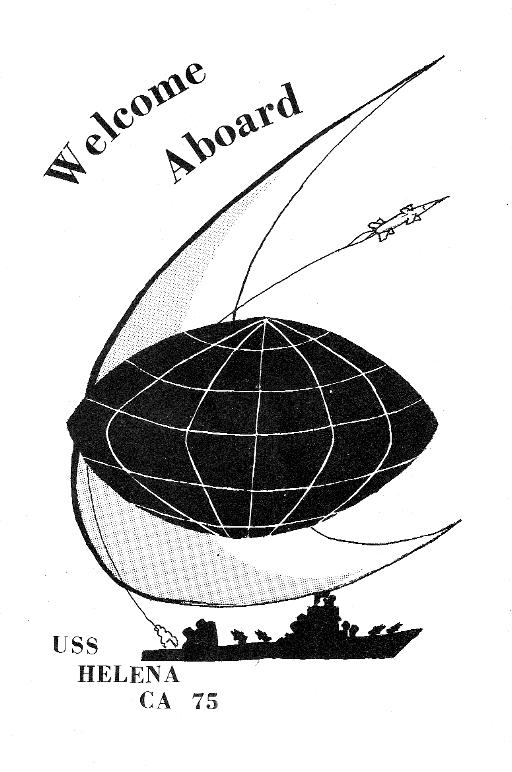
Front Cover - outside
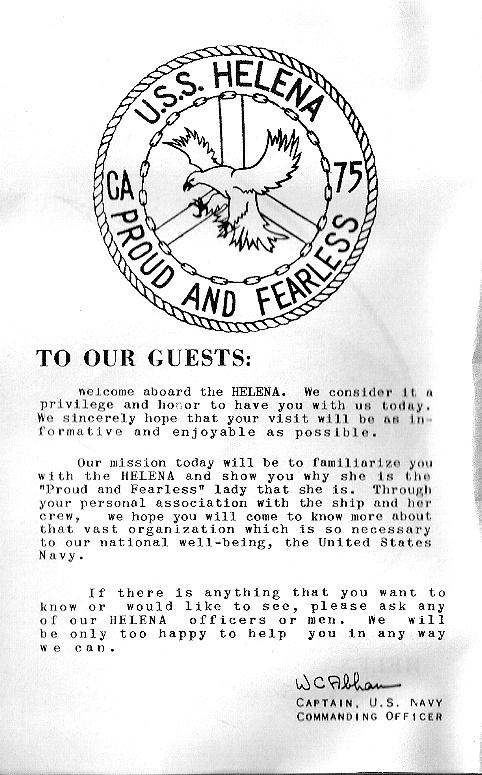
Front Cover - inside
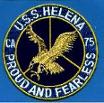

 Front Cover - outside |
 Front Cover - inside |
| HELENA FACTS
Our ship is 675 feet long and her beam at The main engines develop 120,000 horsepower The ship has a completely staffed, fully eq- There are more than 300 telephones on board HELENA's commissary department serves 2,800 The ship maintains a hobby shop, soda foun- Included in her crew of over 1,000 are men HELENA men enjoy a library with several thou- Every two weeks the disbursing officer pays Page 3 |
| COMMANDING OFFICER
Captain William C. Abhau, commanding officer After graduating from the United States Naval Following the war, Captain Abhau served with Captain Abhau's last sea-going command was Since 1940, Captain Abhor has specialized in In addition to serving in the Bureau of Naval |
Captain Abhau holds a Master of Science Captain and Mrs. Abhau, the former Miss |
Pages 4 and 5
| COMMANDER FIRST FLEET
Rear Admiral Frank Virden was born in Cynthia,
After graduation from the Naval Academy, he
Admiral Virden served as Assistant Professor
During the last year of the war he served as
In October 1945, he returned to the U.S. and
Between June 1951 and January 1955, he at-
|
In February 1955, he returned to Washington,
|
Pages 6 and 7
HELENA HISTORY
The second USS Helena (CA-50), a light cruiser,
The third and present USS Helena was commis-
Altogether, the Helena spent three tours of
Since the end of the Korean hostilities, the
Home-based in San Diego, Calif., the Helena is
Pages 10 and 11
FIRST FLEET STORY
Within this broad expanse of ocean, the First
In order to make sure that the First Fleet
To better understand the function and opera-
The majority of the ships, planes and men of
These fleets provide the basic organization
Normally, a "numbered" fleet might be consid-
The types and numbers of ships and other units
Thus. the size of a numbered fleet on any giv- Task Force of First Fleet ships
en day may vary, according to its tasks at the
In the Pacific, the First and Seventh Fleets
The two fleet commanders and their forces do
Thus. the First Fleet is the eastern anchor
It is hoped that the might of the First Fleet
Pages 12 and 13
The consistent policy of the United States is,
The United States Navy has been assigned grave
WHY A CRUISER
The heavy cruiser is an effective weapons sys-
HELENA's modern radar, her long range and
With her speed, imposing armament, her
Page 14 GUARDIAN OF OUR COUNTRY
The United States Navy is responsible for maintaining control of the sea
It is upon the maintenance of this control that our country's glorious
WE SERVE WITH HONOR
Tradition, valor, and victory are the Navy's heritage from the past. To
At home or on distant stations we serve with pride, confident in the respect
Our responsibilities sober us. our adversities strengthen us.
Service to God and Country is our special privilege. We serve with honor.
THE FUTURE OF THE NAVY
The Navy will always employ new weapons. new techniques, and
Now and in the future, control of the sea gives the United States her
Mobility, surprise, dispersal, and offensive power are the keynotes of
Never have our opportunities and our responsibilities been greater
Page 15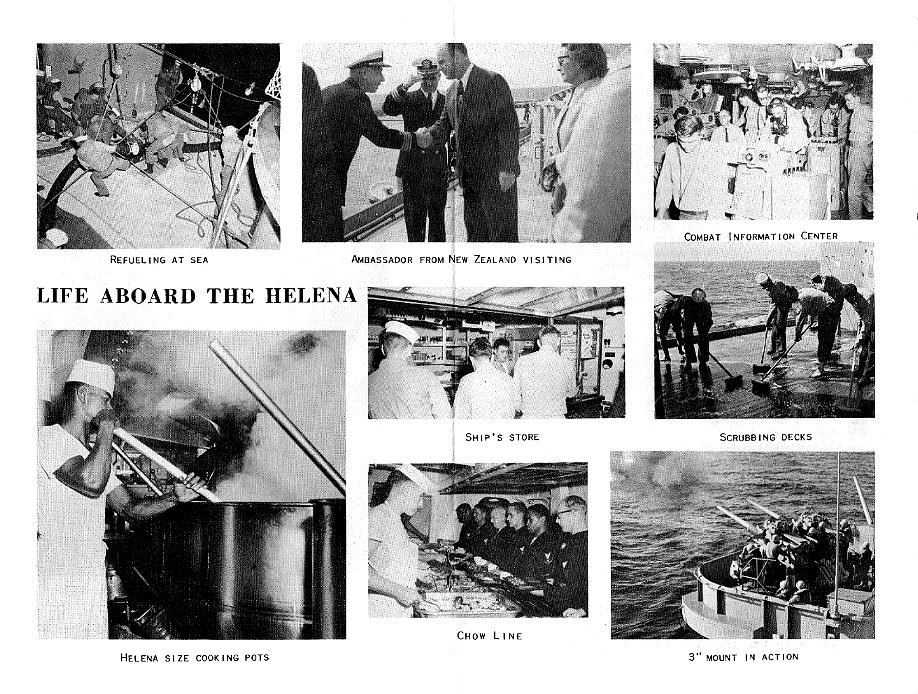
Page 8 and 9
Center Fold
The first USS Helena was a 1,400-ton gunboat.
When stricken from the Navy register in 1932, she
had more than 30 years of distinguished service to
her credit,including participation in the Spanish-
American War.
was commissioned in 1939. Although damaged during
the Japanese attack on Pearl Harbor in 1941, she
was repaired quickly and took part in 13 major en-
gagements in the South Pacific during World War II.
Then, in 1943, while under heavy fire from the en-
emy in the battle of Kula Gulf, she was hit fatal-
ly by a Japanese torpedo and sunk. She was post-
humously awarded the Navy Unit Commendation for
her efforts against the enemy.
sioned in 1945, too late to see action in World
War II. She made up for this with her performance
in the Korean conflict, however. Although she had
just arrived in the United States from the Far
East when hostilities erupted, she returned to
Korean waters in a hurry, and was firing her big
guns at the enemy within six weeks after the
shooting started.
duty in Korean waters--the first heavy cruiser to
do this. Her big guns rained more than 35,000
rounds of death and destruction on the enemy dur-
ing the Korean conflict, and her presence in the
combat zone was a constant threat to Communist
forces in the area.
Helena has served continuously in Pacific waters.
She has flown the flags of more than 20 different
admirals, and has established an envious reputa-
tion for herself as a fighting ship. In 1959 and
1960 she earned the coveted Pacific Fleet Battle
Efficiency ''E'', official recognition of her posi-
tion as the best heavy cruiser in the fleet.
the flagship for the Commander of the U.S. First
Fleet.The USS Helena (CA-75), a heavy cruiser which
displaces 17,200 tons and carries a crew of more
than 1,200 men, was commissioned on Sept. 4, 1945.
Named for the capitol of the state of Montana, she
is the third Navy warship to bear the proud name
of Helena.
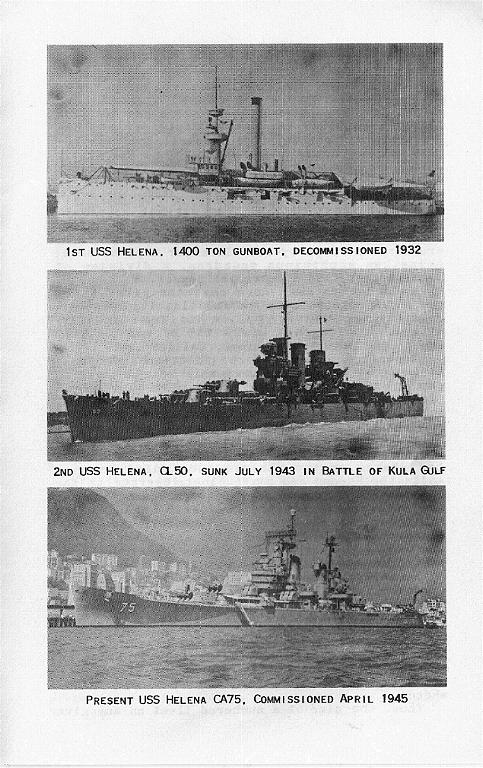
The United states First Fleet is com-
posed of about 100 ships manned by more than
60,000 officers and men. These ships operate from
the west coast of the United States to 160 de-
grees east longitude, approximately half way be-
tween Midway Island and Japan from the Arctic
to the Antarctic.
Fleet exercises operational control over all
ships not assigned to other commands or under-
going repair. This normally includes all aircraft
carriers and their assigned air groups, all
cruisers and destroyers, all major replenishment
ships, an amphibious squadron, a division of
minesweepers, and a destroyer tender.
meets its requirements and fulfills its respons-
ibilities, COMFIRSTFLT flies his two-star flag
at sea. His flagship is the USS Helena (CA-75),
whose home port is San Diego, California.
tion of the First Fleet, it will be necessary to
explain its relationship to other "numbered"
fleets of the U.S. Navy.
the U.S. Navy are presently concentrated within
four "numbered" fleets. The First and Seventh
Fleets generally operate to the west of the Uni-
ted States in the Pacific and Indian Oceans,
while the Second and Sixth Fleets operate to the
east in the Atlantic and Mediterranean Oceans.
through which naval forces, with their associated
air and ground forces, may be moved rapidly to
any spot necessary to safeguard the security of
this country and the free world.
ered the logical extension on a larger scale of
the familiar "task force concept" -- a naval
force assigned to accomplish a specific task.
assigned to a numbered fleet are precisely ad-
justed to the particular task which the fleet is
called upon to accomplish. Ships not needed are
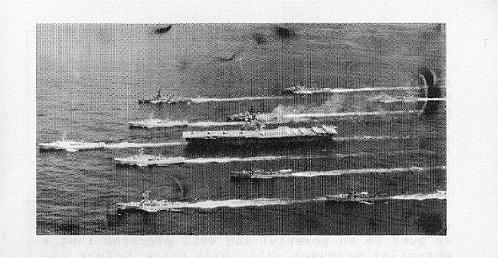
moment. Also, although all four numbered fleets
are assigned to specific geographical ocean
areas, they obviously have to be highly flexible
and prepared for any emergency so they may be
rapidly shifted at a moment's notice.
are responsible for patrolling and protecting the
peace in an area that encompasses 85,000,000
square miles. The First Fleet is assigned the
eastern and middle portion of this vast area. The
Seventh Fleet, under the command of Vice Admiral
W. A. Schoech, is assigned the western portion.
not operate independently of each other, however.
Both are responsible to Admiral John H. Sides,
Commander-in-Chief, Pacific Fleet, who coordin-
ates and directs their activities from his head-
quarters at Pearl Harbor, Hawaii.
for a combat force that covers half the world.
It is a highly mobile, effective and far-reaching
force that is capable of exerting the right
amount of force at the right place at the moment
it becomes necessary.
will never have to be brought to bear against an
enemy who attacks the United States or our al-
lies. But should this happen, the First Fleet is
prepared to safeguard the security of our country
and the Free World.
WHY A NAVY
and has been, to achieve and maintain a just and
stable peace throughout the world. In support of
this endeavor, our government has joined in col-
lective security agreements with 42 countries
around the globe. Access to these nations - our
allies - is of vital importance if we are to at-
tain our common goal of freedom and peace. A
strong, modern, ready Navy can give us this ac-
cess by the seas.
responsibility by you,the American people. First,
we must be so powerful and well-prepared that a
potential aggressor will think twice before at-
tacking us. Second, we must be able to project
the great offensive power of all our armed forces
into enemy territory and away from our home
shores. This we can do by using the terrific
punch of our Naval forces, together with the sup-
port of our world-wide system of Army, Navy, and
Air Force bases. Third, we must be prepared to
support our allies and receive support from them
by the use of the seas. Fourth, our Navy must be
on guard against and be able to control the enemy
submarine menace, now assumed to be one of the
major factors in any future conflict.
tem against enemy ships as well as shore install-
ations. Whether operating with a Fast Carrier
Task Force or an Amphibious Assault Support Unit,
her 3-inch and 5-inch guns provide for her
anti-aircraft defense, and her 8-inch batteries
are the most powerful mobile artillery immediate-
ly available in the world today.
high speed make her valuable as a picket,raider, or in
other roles. She also serves as a high speed
tanker for smaller ships when the need arises and
is the communications center for an entire fleet.
many varied capabilities, and her role as a car-
rier of our country's message of peace, HELENA is
indeed a ship with a purpose.
THE UNITED STATES NAVY
and is a ready force on watch at home and overseas, capable of strong
action to preserve the peace or of instant offensive action to win in war.
future depends. the United States Navy exists to make it so
these may he added dedication. discipline. and vigilance as the watchwords
of the present and the future.
of our country. our shipmates. and our families.
greater power to protect and defend the United States on the sea, under
the sea, and In the air
greatest advantage for the maintenance of peace and for victory in war.
the new Navy. The roots of the Navy lie in a strong belief in the
future, in continued dedication to our tasks. and in reflection on our
heritage from the past